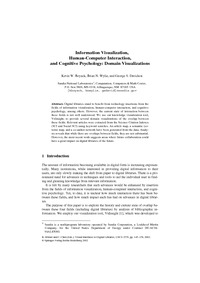Information Visualization, Human-Computer Interaction, and Cognitive Psychology: Domain Visualizations Kevin W. Boyack, George S. Davidson, Brian N. Wylie Kevin W. Boyack, George S. Davidson, Brian N. WylieZu finden in: Visual Interfaces to Digital Libraries (Seite 145 bis 158), 2002
|
 |
 Diese Seite wurde seit 5 Jahren inhaltlich nicht mehr aktualisiert.
Unter Umständen ist sie nicht mehr aktuell.
Diese Seite wurde seit 5 Jahren inhaltlich nicht mehr aktualisiert.
Unter Umständen ist sie nicht mehr aktuell.
 Zusammenfassungen
Zusammenfassungen
 Digital libraries stand to benefit from technology insertions from the fields of information visualization, human-computer interaction, and cognitive psychology, among others. However, the current state of interaction between these fields is not well understood. We use our knowledge visualization tool, VxIn-sight, to provide several domain visualizations of the overlap between these fields. Relevant articles were extracted from the Science Citation Indexes (SCI and Social SCI) using keyword searches. An article map, a semantic (co-term) map, and a co-author network have been generated from the data. Analysis reveals that while there are overlaps between fields, they are not substantial. However, the most recent work suggests areas where future collaboration could have a great impact on digital libraries of the future.
Digital libraries stand to benefit from technology insertions from the fields of information visualization, human-computer interaction, and cognitive psychology, among others. However, the current state of interaction between these fields is not well understood. We use our knowledge visualization tool, VxIn-sight, to provide several domain visualizations of the overlap between these fields. Relevant articles were extracted from the Science Citation Indexes (SCI and Social SCI) using keyword searches. An article map, a semantic (co-term) map, and a co-author network have been generated from the data. Analysis reveals that while there are overlaps between fields, they are not substantial. However, the most recent work suggests areas where future collaboration could have a great impact on digital libraries of the future. im Buch Visual Interfaces to Digital Libraries (2002) im Text Information Visualization, Human-Computer Interaction, and Cognitive Psychology: Domain Visualizations
im Buch Visual Interfaces to Digital Libraries (2002) im Text Information Visualization, Human-Computer Interaction, and Cognitive Psychology: Domain Visualizations  Dieser Text erwähnt ...
Dieser Text erwähnt ...
 Begriffe KB IB clear | HCI/MMI (Human-Computer-Interaction)Human-Computer-Interaction
, SPIRE
,  ThemeScape
, ThemeScape
,  Visualisierung Visualisierung visualization
, VRML
, Zitationsanalysecitation analysis visualization
, VRML
, Zitationsanalysecitation analysis
|
 Volltext dieses Dokuments
Volltext dieses Dokuments
 |  Information Visualization, Human-Computer Interaction, and Cognitive Psychology: Domain Visualizations: Artikel als Volltext ( Information Visualization, Human-Computer Interaction, and Cognitive Psychology: Domain Visualizations: Artikel als Volltext ( : :  , 485 kByte; , 485 kByte;  : :  2021-03-21) 2021-03-21) |
 Anderswo suchen
Anderswo suchen 
 Beat und dieser Text
Beat und dieser Text
Beat war Co-Leiter des ICT-Kompetenzzentrums TOP während er Dieser Text ins Biblionetz aufgenommen hat. Die bisher letzte Bearbeitung erfolgte während seiner Zeit am Institut für Medien und Schule. Beat besitzt kein physisches, aber ein digitales Exemplar. Eine digitale Version ist auf dem Internet verfügbar (s.o.). Aufgrund der wenigen Einträge im Biblionetz scheint er es nicht wirklich gelesen zu haben. Es gibt bisher auch nur wenige Objekte im Biblionetz, die dieses Werk zitieren.









 Biblionetz-History
Biblionetz-History